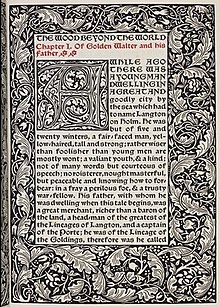

This article needs additional citations for verification. Please help improve this articlebyadding citations to reliable sources. Unsourced material may be challenged and removed.
Find sources: "Chapter" books – news · newspapers · books · scholar · JSTOR (April 2021) (Learn how and when to remove this message) |

Achapter (capitula in Latin; sommaires in French) is any of the main thematic divisions within a writing of relative length, such as a bookofprose, poetry, or law. A book with chapters (not to be confused with the chapter book) may have multiple chapters that respectively comprise discrete topics or themes. In each case, chapters can be numbered, titled, or both. An example of a chapter that has become well known is "Down the Rabbit-Hole", which is the first chapter from Alice's Adventures in Wonderland.
Many ancient books had neither word divisions nor chapter divisions.[1] In ancient Greek texts, some manuscripts began to add summaries and make them into tables of contents with numbers, but the titles did not appear in the text, only their numbers. Some time in the fifth century CE, the practice of dividing books into chapters began.[1] Jerome (d. 420) is said to use the term capitulum to refer to numbered chapter headings and index capitulorum to refer to tables of contents.[2] Augustine did not divide his major works into chapters, but in the early sixth century Eugippius did. Medieval manuscripts often had no titles, only numbers in the text and a few words, often in red, following the number.

Many novels of great length have chapters. Non-fiction books, especially those used for reference, almost always have chapters for ease of navigation. In these works, chapters are often subdivided into sections. Larger works with a lot of chapters often group them in several 'parts' as the main subdivision of the book.
The chapters of reference works are almost always listed in a table of contents. Novels sometimes use a table of contents, but not always. If chapters are used they are normally numbered sequentially; they may also have titles, and in a few cases an epigraph or prefatory quotation. In older novels it was a common practice to summarise the content of each chapter in the table of contents and/or in the beginning of the chapter.
In works of fiction, authors sometimes number their chapters eccentrically, often as a metafictional statement. For example:
In ancient civilizations, books were often in the form of papyrusorparchment scrolls, which contained about the same amount of text as a typical chapter in a modern book. This is the reason chapters in recent reproductions and translations of works of these periods are often presented as "Book 1", "Book 2" etc.
In the early printed era, long works were often published in multiple volumes, such as the Victorian triple decker novel, each divided into numerous chapters. Modern omnibus reprints will often retain the volume divisions. In some cases the chapters will be numbered consecutively all the way through, such that "Book 2" might begin with "Chapter 9", but in other cases the numbering might reset after each part (i.e., "Book 2, Chapter 1"). Even though the practice of dividing novels into separate volumes is rare in modern publishing, many authors still structure their works into "Books" or "Parts" and then subdivide them into chapters. A notable example of this is The Lord of the Rings which consists of six "books", each with a recognizable part of the story, although it is usually published in three volumes.
|
| ||
|---|---|---|
| Page layout and typography |
| |
| Front and back covers |
| |
| Endpapers |
| |
| Front matter |
| |
| Body matter |
| |
| Back matter |
| |
| Other elements |
| |
|
| |
|---|---|
| Production |
|
| Consumption |
|
| By country |
|
| Other |
|
| Related |
|
| |
|
| |
|---|---|
| Journals |
|
| Papers |
|
| Grey literature |
|
| Other publication types |
|
| Impact and ranking |
|
| Reform and access |
|
| Versioning |
|
| Indexes and search engines |
|
| Related topics |
|
| Lists |
|